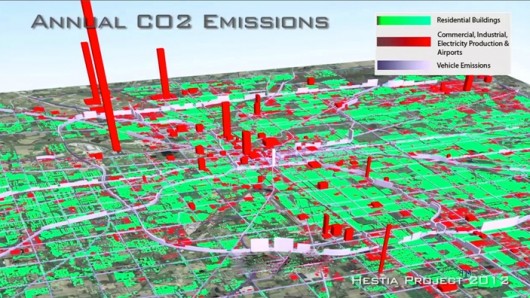As the old adage goes, knowledge is power. Following this principle, Arizona State University researchers have developed a computer program called Hestia, that is capable of estimating the greenhouse gas emissions of specific roads and even buildings. With its high level level of detail and accuracy, the software can help cities make more precise calculations about their GHG footprint as well as more informed decisions related to carbon mitigation efforts.
To obtain such precise information, Hestia draws on sources such as local air pollution reports, traffic counts, and property information available to tax assessors known as the APN (assessor’s parcel number). That data is combined with a modeling system that quantifies CO2 emissions on a micro level, such as for individual buildings and streets.
“Cities have had little information with which to guide reductions in greenhouse gas emissions – and you can’t reduce what you can’t measure,” said Kevin Gurney, an associate professor in ASU’s School of Life Sciences and senior scientist with the Global Institute of Sustainability.
Indianapolis has been the first city where Hestia has been tested, where it is part of the INFLUX experiment, a project designed to improve methods of greenhouse gas flux measurements. Los Angeles and Phoenix will follow. The overall goal is create a CO2 map in every major American city and give local leaders clear data that is easy to understand and, consequently, conducive to more effective action.
Additionally, the researchers hope the software can provide a tool for independent emission audits. These may help persuade reluctant countries, who may be won over by the introduction of an independent verification system, to join an international climate change treaty.
Besides providing a calculation tool for cities, Hestia is expected to complement NASA’s Orbital Carbon Observatory satellite, the launch of which is planned for 2013. The satellite will measure the concentration of CO2 in the earth’s atmosphere.
Hestia was featured in Environmental Science and Technology magazine earlier this month.
The video below illustrates how the software works.
Source: Arizona State University

